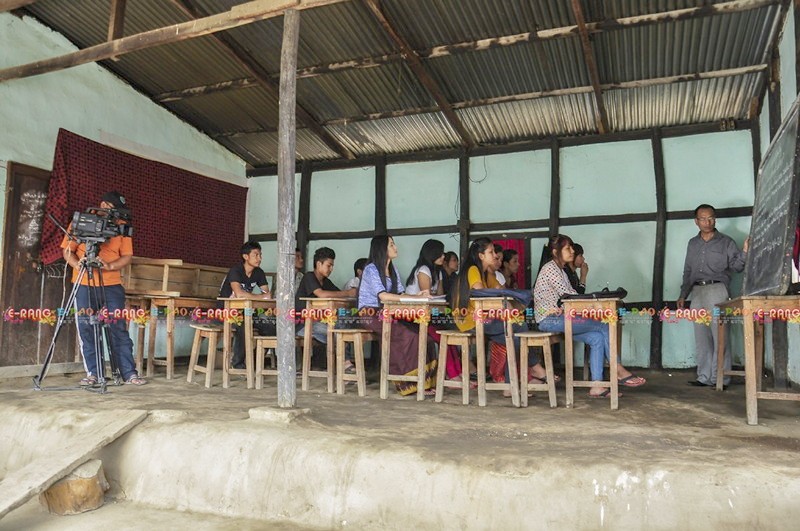Manipuri Cinema as an escape route :: Part 2
Bobby Wahengbam *

A scene from 'Amukta Ani''
After they have become conscious in filmmaking, their body of work in the commercial mode are not as successful as earlier at the box office. They could no longer enjoy the privileged space they used to occupy in the commercial world. The more one becomes conscious, the more he is distancing from the public. It can signify that the art and commercial has not merged enough in our world and we do need education in film arts and crafts to be part of the world cinema rather than being a world of our own in a box. The sharp dichotomy of the two schools is also strongly felt by Pubung Aribam Syam.
At least in India, the distinction between 'Art' and 'Commercial' still prevails. The lobby and influence of the commercial film world is so powerful that awards like 'wholesome entertainment' has been introduced. More than that there are five awards in the category representing five regional commercial film industries.
Basically, the so called 'mainstream' commercial films find it tough to enjoy awards in other existing categories of cinematic excellence which resulted in introducing such populist awards. Nevertheless, every body has their own right to venture into any style they prefer. Unluckily, in Manipur, we're all venturing into the world of so called 'popular film'. No issue, but it could not represent the real Manipuri Cinema.
We should also make presentable film that can find respectable space in cinematic excellence in National and International pitch (Syam, AMVFPA,MFDC, 2012). Pabung was very concerned about the present status of Manipuri cinema.
The discussion of the day organised by AMVFMPA was on the prospect of Manipuri cinema concerning the long drought in National Award in the feature film category even failing to win the exclusive 'the best Manipuri feature film' category. But art film is not a cup of tea of any third person as it requires extensive research and study. At the same time, many has criticised the commercial films for lack of originality and aesthetic sensibility and being disposable.
But in the trade, the basic premise is 'profit' which seems to be more realistic when money has become the common denominator for every value today.
Unfortunately, we have been having 'bad education' so far with the bombardment of South Indian flicks, Bollywood loud blockbusters, Korean melodramatic Serials, Sumang Leela verbose and our own run-of-the-mill assembly line films. In the midst of all gold less glitters, the effort of TC Foundation and MFDC is worth praising for.
Screening of films and discussion thereafter seems to provide a breathing space for the growth of good cinema in the state. It has an essence parallel to the French New Wave movement as it is a platform for discussing films. 'The last Saturday of the month screening' is a place not for just watching but for learning with a certain sense of cohesion.
The 'band of outsider' as cahiers critics of French New Wave called them selves; these outsiders of popular Manipuri film circle help one another in their short and documentary film production. One director uses footage of another director whenever required. Collaboration among them is also a reality. 'AFSPA 1958', one of the best documentary films of India would not have seen the light of the day without the collaborative effort of Sanzu and Paban. Again, discussions about a film in the making become a habit. Such tradition was witnessed among the French New Wave directors.
The main players in the New Wave had a firm policy of helping each other to established themselves – commitment that's been labeled a 'politique des copains'. It is perhaps this collaborative policy that created the stylistic similarities between the films of the 'New Wave'. Sometimes, the directors swapped projects for one rea son or another. Truffaut passed on to Godard 400 feet of film he had shot observing the floods in Paris, and from these beginning, Godard made Une Histoire d'Eau (1958), acting as screenwriter, director and editor (Wiegand Chris, 2007.p.24).
Another milestone that changes the texture of Manipuri cinema is the endeavor of Cine directors' guild. The successful organisation of short film festival could bring the film makers and audience to another level which mpact is expected to enhance the production of full length feature film. If the tradition of helping each other in bettering the fine nuances of film making attract the feature film fraternity, it would surely help vertical inclination of Manipuri cinema.
But at the end of the day, it is commercial film that is providing livelihood to thousands of families directly and indirectly in the land where rate of unemployment is extremely high. One needs to work every day here to keep the fire of the kitchen burning. Inability of doing a good work in our present scenario for want of prospects, apathy, support and patronage leads to growth of Manipuri cinema horizontally.
But we have to scale this limitation to preserve the respect Manipuri cinema used to enjoy. For that, extensive study in the field of art and aesthetic of cinema is called for at the moment like French New Wave directors did before venturing into film making. And more than that we, urgently, need film studies in our educational curriculum to empower the general masses and the filmmakers alike. Any takers?
Concluded
